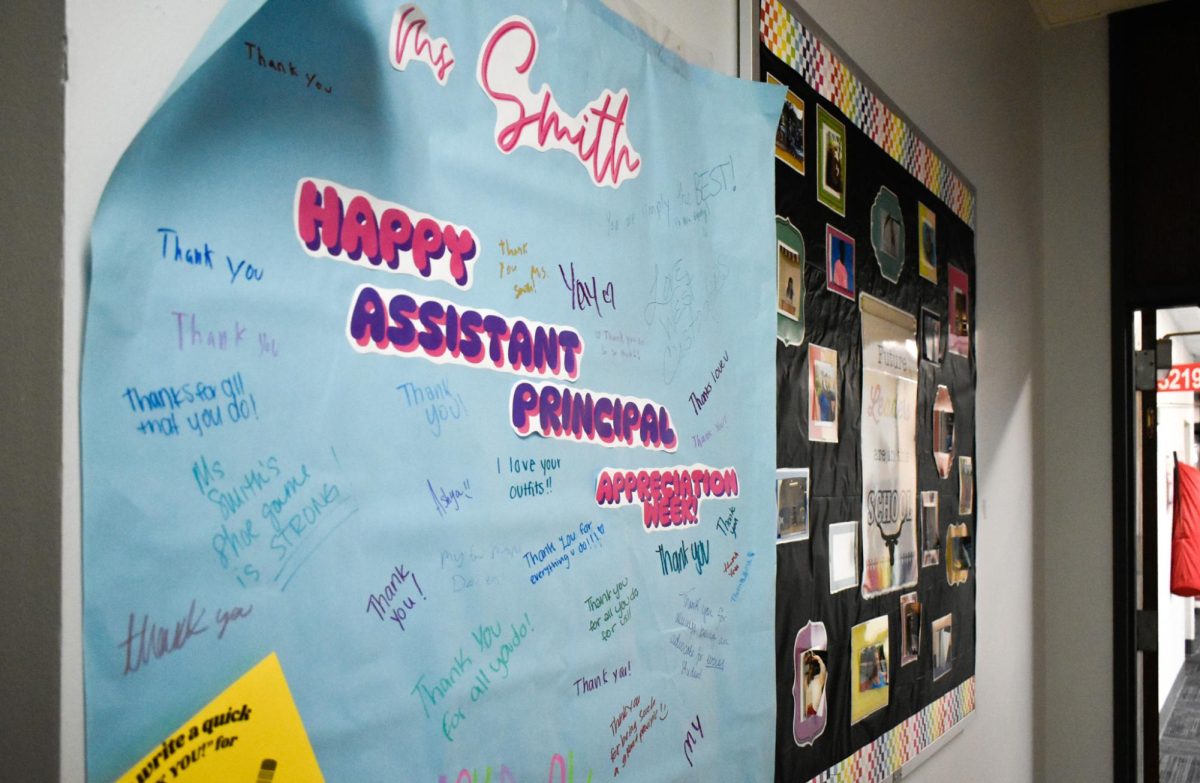In the modern global market, environmentally-friendly products are rising to the top of fashion trends. Whether itтАЩs a hunter-green backpack or the trend of тАШthrifting,тАЩ many teens find it fashionable to show off how sustainable they are. But as these trends rise in popularity, so do companies who attempt to take advantage of their customers.┬а
The fashion industry participates in certain practices severely detrimental to society, such as fast fashion and greenwashing. Fast fashion is a business model certain leading brands utilize even though it is extremely dangerous for the environment. Greenwashing is a strategy companies use to convince consumers to buy their products under the guise of being тАЬenvironmentally friendly.тАЭ Consumers must stay informed and vigilant to ensure they are not falling for these methods.
Fast fashion
Fast fashion is a business model where companies cheaply manufacture trendy clothing at a fast speed to meet consumer demand. Because fast fashion companies supply the newest styles on the market as quickly as possible, shoppers can snatch them up while they are still at the height of their popularity, then discard them after a few wears when theyтАЩre no longer in style.┬а
This destructive cycle forms a key part of overproduction and consumption, making fashion one of the worldтАЩs largest polluters. Yet, many consumers take part in the fast fashion industry without realizing it. This is partially due to companiesтАЩ use of greenwashing tactics to mislead well-meaning consumers.
In other areas, such as the food, cleaning supplies or car industry, consumers tend to consider the effects of the products they buy much more often. But in the fashion industry, many consumers neglect the standards they hold close to when buying other products. To see a shift in this trend, consumers need to become conscious of their carbon footprints, especially in what they wear.
One brand infamous for using fast fashion practices is SHEIN, with just 6% of its inventory remaining in stock for more than 90 days. The company creates about 50-100 items per design, with hundreds of new designs each day, totaling around 10,000 products per day. If a design sells well, more batches are commissioned; if not, the lines are immediately discontinued, and any unsold extras are thrown away. On top of that, SHEIN ships to over 150 countries тАФ a sobering thought when considering that the emissions created by trucks, ships and planes come not just from deliveries but also from returns. Many returns end up in landfills because it costs more to put them back in circulation, especially in the fast fashion industry.┬а┬а
SHEIN is the epitome of fast fashion, and yet, the company was worth $47 billion in 2021. This is only possible because SHEIN and many other fast fashion companies profit off customers who read the $5 tag on a dress and snatch it up without thinking about the potential labor exploitation or lasting environmental costs theyтАЩre contributing to. Between carbon emissions and тАЬclothing dumping,тАЭ the fashion industry is one of the leading contributors to climate change тАФ yet these companies continue to thrive. Even if students donтАЩt buy from SHEIN or other fast fashion brands, they need to be aware of the impact that their clothing habits have on the people around them. Ninety-two million tons of garments end up in landfills, and 100 billion garments are produced by the fashion industry each year.
Fast fashion is pervasive in school environments as well. Students buy Prom and Homecoming dresses that are typically only ever worn once. Seniors must buy graduation caps and gowns that they will never wear again. New school supplies being bought for every subject each year, when supplies such as binders typically donтАЩt need replacing after just one school year. Student consumers who recognize these unsustainable practices in their daily lives can make a real difference.
Greenwashing
Another concept that teen consumers need to keep in mind is greenwashing, referring to when a company makes an unsubstantiated claim about its environmental practices. Greenwashing is used to deceive consumers into believing that a company’s products are environmentally friendly or inflate their actual environmental benefits to advertise their product and increase their prices.

Greenwashing comes in many forms throughout the market. Still, there are a few common claims in the fashion industry, the first of which is having an environmentally friendly line of clothing or a few clothes that have a green tag on them. Another popular claim is that a certain percentage of a brandтАЩs clothing is made with recycled materials when this practice probably isnтАЩt helping the environment at all. Additionally, a company may advertise its sustainable goals for the future while neglecting to share what initiatives theyтАЩre taking at the current moment. Dominating fashion brands such as Lululemon, Adidas, Forever 21 and H&M have all used these methods and combined them to lead customers to believe that they are more environmentally friendly than they seem.┬а
These misleading practices allow companies to raise product prices solely because theyтАЩre claiming to be sustainable. So while it is a start that the consumer demand wants more environmentally friendly products, they need to be aware that companies that use these methods do not compensate for the overwhelming majority of their unsustainable practices. Even worse, companies could still be outright lying about these practices as well, as was the case for H&M.
In many cases, the concept of greenwashing тАФ as well as deciding if a brand is ethical is inherently subjective. This is especially true when information is hard to find, or a brand intentionally sits in a gray area, making it difficult for a consumer to decide whether or not the company has ethical practices. Many mainstream clothing lines make minor, easily-adjustable changes to тАЬcheck the boxтАЭ of being a sustainable brand when in reality, these practices do not offset the companyтАЩs carbon footprint. This gray area gives consumers room to write off their guilt about buying unsustainable products by saying that companies are helping the sustainable cause, leading them to ignore the brandтАЩs overall practices and buy the clothing anyway. Ultimately, consumers need to decide where the line between ethical and unethical lies and buy products accordingly.┬а
Sustainable Solutions
While the trending demand for environmentally friendly practices from the fashion industry is better than nothing, student consumers need to be conscious that not every claim a product is making is true or defendable. Though it certainly may be easier to scroll through social media and let others spew angry claims that a brand is bad for the environment, consumers need to research and decide for themselves. Not only should students partake in sustainable fashion practices, but they should also advocate for themselves and change the opinions of those around them. Some resources can help to do just that.┬а
Good On You is an organization that groups brands by specific categories to assist consumers beginning their journey to ethical shopping. The three main categories are тАЬPeople,тАЭ which filters for companies that practice fair trade and promote healthy working standards, “Earth,” which filters for companies that practice sustainability and тАЬAnimals,тАЭ for companies that practice cruelty-free habits. Not only do they allow filtering based on specific classifications, but Good On You has тАЬBrand RatingsтАЭ on thousands of fashion brands, serving as a search engine for eco-friendly fashion and a reliable source of opinions on ethical fashion.
However, as much as shopping ethically is admirable, ethical fashion can be expensive, and it takes a lot of time and effort to research brands that meet a consumer’s standards. Not every student тАФ let alone consumer тАФ can make ethical fashion feasible for them. Luckily, the best way to be environmentally friendly is simple: buy less. Not only does this save consumersтАЩ wallets, but it also breaks the fast fashion cycle. And although thrifting may seem like just a trendy concept, consumers can take the trend seriously. Donating clothes instead of throwing them away and checking local second-hand shops for outfits is one of the best ways to be more sustainable and reuse clothes.
Consumers are powerful in the industry market because of their ability to choose. If the market demands real eco-friendly clothing and consumers reward genuinely sustainable brands with their money instead of the ones that are not, companies have no choice but to supply that demand and lower their carbon footprint. For change to happen, stay conscious and stay vigilant.


![Dressed up as the varsity girlsтАЩ tennis coach Katelyn Arenos, senior Kate Johnson and junior Mireya David hand out candy at West HighтАЩs annual trunk or treat event. This year, the trunk or treat was moved inside as a result of adverse weather. тАЬAs a senior, I care less about Halloween now. Teachers will bring their kids and families [to WestтАЩs Trunk or Treat], but there were fewer [this year] because they just thought it was canceled [due to the] rain. [With] Halloween, I think you care less the older you get,тАЭ Johnson said.](https://pwestpathfinder.com/wp-content/uploads/2025/10/DSC00892-1-1200x800.jpg)
![Leaning on the podium, superintendent Melissa Schneider speaks to Parkway journalism students during a press conference. Schneider joined Parkway in July after working in the Thompson School District in Colorado. тАЬMy plan [to bond with students] is to get things on my calendar as much as possible. For example, being in [classes] is very special to me. I am trying to be opportunistic [meeting] kids [and] being in [the school] buildings. I have all the sports schedules and the fine arts schedules on my calendar, so that when I'm available, I can get to them,тАЭ Schneider said.](https://pwestpathfinder.com/wp-content/uploads/2025/09/IMG_5425-1200x943.jpeg)


![Red, white and blue, the American flag holds the values of our democracy. The fight that we once endured has returned, as student journalists and senior correspondents across the country are losing their voices due to government control. тАЬ[Are] the White House and [the] government limiting free speech [and] freedom of the press? Yes [they are],тАЭ chief communications officer of the Parkway School District and former journalist Elisa Tomich said.](https://pwestpathfinder.com/wp-content/uploads/2025/03/Untitled-design-14.jpg)
![A board in the Parkway West counseling department displays pennants of selective universities. With a wide range of students interested in attending, itтАЩs important that these schools have clear priorities when deciding who to admit. тАЬ[Washington University] had the major that I wanted, psychology, philosophy, neuroscience. That's a holistic study of the brain, and [WashU is] the only college in the world that offers that. That's the main reason I wanted to go; I got into that program,тАЭ senior Dima Layth said.](https://pwestpathfinder.com/wp-content/uploads/2025/02/Flag-1.png)

![Within the U.S., the busiest shopping period of the year is Cyber Week, the time from Thanksgiving through Black Friday and Cyber Monday. This year, shoppers spent $13.3 billion on Cyber Monday, which is a 7.3% year-over-year increase from 2023. тАЬWhen I was younger, I would always be out with my mom getting Christmas gifts or just shopping in general. Now, as she has gotten older, I've noticed [that almost] every day, I'll open the front door and there's three packages that my mom has ordered. Part of that is she just doesn't always have the time to go to a store for 30 minutes to an hour, but the other part is when she gets bored, she has easy access to [shopping],тАЭ junior Grace Garetson said.](https://pwestpathfinder.com/wp-content/uploads/2024/12/DSC_0249.JPG-1200x801.jpg)

![Senior Sally Peters stands in the history hallway, contemplating her choices in the 2024 United States and Missouri elections on Nov. 5. As a member of Diplomacy Club, Peters has discussed key candidates and issues in contemporary American politics. тАЬ[As students], we're starting to become adults. We're realizing how much the policies that are enforced and the laws that make it through the House and Senate are starting to affect us. [Opportunities such as] AP [U.S.Government] and Diplomacy Club [make elections feel] a lot more real,тАЭ Diplomacy Club vice president and senior Nidhisha Pejathaya said.](https://pwestpathfinder.com/wp-content/uploads/2024/10/Flag-1-1.png)
![Sitting courtside before a junior varsity girlsтАЩ tennis match, senior Tanisi Saha rushes to finish her homework. Saha has found herself doing academic work during her athletic activities since her freshman year. тАЬBeing in sports has taught me how to stay organized and on top of my schoolwork. [With] a busy practice and game schedule, IтАЩve learned to manage my homework and study time better,тАЭ Saha said.](https://pwestpathfinder.com/wp-content/uploads/2025/11/DSC_0022-1200x800.jpg)
![Sophomore Maryem Hidic signs up for an academic lab through Infinite Campus, a grading and scheduling software. Some students enjoyed selecting their responsive schedule in a method that was used school-wide last year. тАЬI think it's more inconvenient now, because I can't change [my classes] the day of, if I have a big test coming and I forget about it, I can't change [my class],тАЭ sophomore Alisha Singh said.](https://pwestpathfinder.com/wp-content/uploads/2025/10/DSC_0012-1200x801.jpg)
![Senior Dhiya Prasanna examines a bottle of Tylenol. Prasanna has observed data in science labs and in real life. тАЬ[I] advise the public not to just look or search for information that supports your argument, but search for information that doesn't support it,тАЭ Prasanna said.](https://pwestpathfinder.com/wp-content/uploads/2025/10/DSC_0073-2-1200x800.jpg)
![Junior Fiona Dye lifts weights in Strength and Conditioning. Now that the Trump administration has instituted policies such as AI deregulation, tariffs and university funding freezes, women may have to work twice as hard to get half as far. "[Trump] wants America to be more divided; he wants to inspire hatred in people,тАЭ feminist club member and junior Clara Lazarini said.](https://pwestpathfinder.com/wp-content/uploads/2025/05/Flag.png)
![As the Trump administration cracks down on immigration, it scapegoats many immigrants for the United StatesтАЩ plights, precipitating a possible genocide. Sophomore Annabella Whiteley moved from the United Kingdom when she was eight. тАЬItтАЩs pretty scary because IтАЩm on a visa. When my visa expires next year, IтАЩm not sure whatтАЩs going to happen, especially with [immigration] policies up in the air, so it is a concern for my family,тАЭ Whiteley said.](https://pwestpathfinder.com/wp-content/uploads/2025/05/DSC_0077-7copy.jpg)
![Shifting global trade, President Donald TrumpтАЩs tariffs are raising concerns about economic stability for the U.S. and other countries alike. тАЬ[The tariffs are] going to pose a distinct challenge to the U.S. economy and a challenge to the global economy on the whole because it's going to greatly upset who trades with who and where resources and products are going to come from,тАЭ social studies teacher Melvin Trotier said.](https://pwestpathfinder.com/wp-content/uploads/2025/05/MDB_3456-1200x800.jpg)



![Some of the most deadly instances of gun violence have occurred in schools, communities and other тАШsafe spacesтАЩ for students. These uncontrolled settings give way to the need for gun regulation, including background and mental health checks. тАЬGun control comes about with more laws, but there are a lot of guns out there that people could obtain illegally. What is a solution that would get the illegal guns off the street? We have yet to find [one],тАЭ social studies teacher Nancy Sachtlaben said.](https://pwestpathfinder.com/wp-content/uploads/2025/01/DSC_5122-1200x800.jpg)

![Sophomore Shree Sikkal Kumar serves the ball across the court in a match against Lindbergh. Sikkal Kumar has been a varsity member of the varsity girlsтАЩ tennis team for two years, helping her earn the number two rank in Class 2 District 2.тАЬWhen matches are close, itтАЩs easy to get nervous, but I [ground] myself by[staying] confident and ready to play,тАЭ Sikkal Kumar said.](https://pwestpathfinder.com/wp-content/uploads/2025/11/DSC2801-1200x798.jpg)
![Focused on providing exceptional service, sophomore Darsh Mahapatra carefully cleans the door of a customerтАЩs car. Mahapatra has always believed his customers deserve nothing less than the best. тАЬ[If] theyтАЩre trusting us with their car and our service, then I am convinced that they deserve our 100 percent effort and beyond,тАЭ Mahapatra said.](https://pwestpathfinder.com/wp-content/uploads/2025/10/DSC_0018-1200x800.jpg)
![Sophomore Aleix Pi de Cabanyes Navarro (left) finishes up a soccer game while junior Ava Muench (right) warms up for cross country practice. The two came to Parkway West High School as exchange students for the 2025-2026 school year. тАЬThe goal for the [exchange] program is to provide opportunities for both Parkway students and our international exchange students to learn about other cultures, build connections and become confident, capable, curious and caring тАФ ParkwayтАЩs Four CтАЩs тАФ in the process,тАЭ Exchange Program Lead Lauren Farrelly said.](https://pwestpathfinder.com/wp-content/uploads/2025/10/Feature-Photo-1200x800.png)
![Gazing across the stage, sophomore Alexis Monteleone performs in the school theater. The Monteleone familyтАЩs band тАЬMonte and the MachineтАЭ has been releasing music since 2012, but Alexis started her own solo career in 2024 with the release of her first single, Crying Skies. тАЬMy whole family is very musical, [and I especially] love writing [songs with them],тАЭ Monteleone said.](https://pwestpathfinder.com/wp-content/uploads/2025/09/DSC7463-1200x798.jpg)

![Leaping through the air, senior Tyler Watts celebrates his first goal of the season, which put the Longhorns up 1-0 against the Lafayette Lancers. Watts decided to play soccer for West for his last year of high school and secured a spot on the varsity roster. тАЬ[Playing soccer for West] is something I had always dreamed of, but hadnтАЩt really had a good opportunity to do until now. ItтАЩs [really] fun being out [on the field], and IтАЩm glad I decided to join the team. ItтАЩs just all about having fun with the boys and enjoying what time we have left together,тАЭ Watts said.](https://pwestpathfinder.com/wp-content/uploads/2025/09/DSC_1951-1200x855.jpg)

![Pitching the ball on Apr. 14, senior Henry Wild and his team play against Belleville East. Wild was named scholar athlete of the year by St. Louis Post-Dispatch after maintaining a high cumulative GPA and staying involved with athletics for all of high school. тАЬItтАЩs an amazing honor. I feel very blessed to have the opportunity to represent my school [and] what [it] stands for,тАЭ Wild said.](https://pwestpathfinder.com/wp-content/uploads/2025/05/unnamed-6-1200x714.jpg)
![Freezing in their position, the Addams Family cast hits the тАЬrigor mortisтАЭ pose after cast member and senior Jack Mullen, in character as Gomez Addams, calls out the stiff death move. For the past four months, the combined company of cast members, orchestra pit, crew and directors all worked to create the familial chemistry of the show. тАЬIтАЩm excited for [the audience] to see the numbers, the music, the scenes, but I also just love all the technical aspects of it. The whole spectacle, the costumes, makeup and the people that put in the work backstage in order to make the show successful on stage. IтАЩm excited for people to see and appreciate that,тАЭ Mullen said.](https://pwestpathfinder.com/wp-content/uploads/2025/03/DSC0116-1200x800.jpg)
Jared • Nov 28, 2022 at 9:32 pm
Love the citations and linked resources. The images of clothing dumps are heartbreaking and I’m glad to see this important issue getting attention.
Laurel • Nov 28, 2022 at 12:00 pm
Very informative! Thank you for showing the problem but also offering solutions.